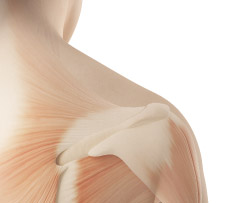Do you ever feel like you’ve got the weight of the world on your shoulders? Well, you’re not too far off. Shoulders are the most commonly injured joints, and the ones to most likely need operating procedures like surgery to recover. An injured shoulder or rotator cuff can reduce and restrict your arm movement to such a strong degree that you may not even be able to brush your teeth, and forget about other activities such as sports, or even light lifting.
Dr. Skedros is an acclaimed veteran of shoulder operations, being the first ever surgeon in Utah who has been fellowship trained to operate on them. He is a prolific writer on a variety of shoulder procedures and how to keep those joints sturdy and strong. He is also one of the few surgeons willing to perform a shoulder fusion operation. Take a look at the various procedures below.
See “Patient Resources” for information for what to do before and after surgery.
Some rotator cuff tendon tears can't be repaired in a standard way. If you have this problem you probably have also had several rotator cuff surgeries without great success. Dr. Skedros can determine if you are a good candidate for graft "patching" (see the diagram).
Arthroscopic ("scope") surgery can be effective for many shoulder conditions, including instability, labrum tears, small rotator cuff tendon tears, and shoulder impingement. Dr. Skedros can usually do these surgeries with only 3-4 stitches, and he can determine if you would benefit from arthroscopy or from a "mini-open" procedure, or both.
AC separations usually do not require surgery. But if you have a type that does then Dr. Skedros uses an advanced method to correct it (see the diagrams and video by following the link below).
Dr. Skedros routinely performs the entire spectrum of shoulder replacements. See the x-rays for examples. Also see the article that he co-authored in the late 1990s, which includes one of the earliest demonstration of a "reverse" shoulder replacement in the USA.
The weak link of a conventional shoulder replacement is the artificial socket. Dr. Skedros can help reconstruct your shoulder if you have a loose socket or an unstable shoulder replacement. He can also manage an infected shoulder replacement. See the article showing that he has managed the worst; namely, unusual fungus infections.
Shoulder, clavicle (collarbone), and scapula (shoulder blade) fractures often result from falls, sports, and motor vehicle accidents. Symptoms of fractures include, pain, grinding sounds, bruising, swelling and decreased movement. Treatment typically includes immobilization, physical therapy, and surgery (often involving plates, screws or pins). Many shoulder, clavicle (collarbone), and scapula (shoulder blade) fractures can be tricky to repair well. Dr. Skedros has over 15 years experience in repairing a myriad of fracture types. He can handle complex cases and has practical experience in knowing how to avoid complications (see his article and the x-rays).
Frozen shoulder occurs when the tissue surrounding the shoulder joint contracts, restricting movement. This can be a very painful and debilitating problem. Although it is unclear why frozen shoulder happens, it is more likely to develop after trauma, surgery, strokes or any condition when movement in the shoulder is decreased over time. There are many different treatment methods, from over-the-counter pain relievers, therapy, injections and sometimes surgery. Dr. Skedros has a high success rate in correcting this problem without surgery. Schedule your appointment in Salt Lake City today to start your recovery process.
If your shoulder remains unstable despite many surgeries, then come to see Dr. Skedros for an opinion about advanced options.
This is one of the most painful conditions known. Dr. Skedros employs a non-operative method to correct this problem. If it cannot be corrected, then the technique that he uses enhances the success of surgery (should you eventually need it).
Dr. Skedros performs all of these muscle transfers as a means for restoring shoulder and/or shoulder blade function (see his published articles).
Shoulder infections are often caused by bacteria that do NOT require oxygen. Symptoms include: swelling, redness and pain in the shoulder, sometimes along the upper arm as well. Shoulder infections must be treated as soon as possible to prevent additional complications. In many cases Dr. Skedros keeps his patients in the hospital overnight so they receive additional doses of advanced intravenous (iv) antibiotics. This can be done and still maintain the "same day" status (insurance companies actually allow 23 hour stays in the hospital and they cover your costs just like they would if you went home 2-3 hours after the operation).
This is a problem at the location where the breast bone (sternum) meets the collar bone. This is an uncommon problem in a tricky area. Definitely get a second and third opinion before having work done here. Dr. Skedros has advanced training in reconstructing this area with tendon grafts.
This is usually the last resort for a painful shoulder with very bad arthritis and/or instability. Very few surgeons perform this operation. See Dr. Skedros' article on this topic – it shows that in addition to performing this surgery he can also handle complications associated with it.
Schedule Your Appointment Today
Please contact us for everything you need.

